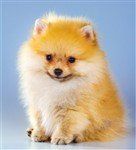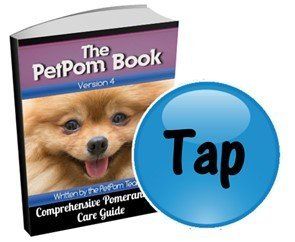Pomeranian Grooming - Puppies and Adults
Why Proper Groomingis So Vital
Overview
Pomeranians require a moderate amount of grooming. The tasks involved are done to promote good hygiene, good health, and for aesthetic reasons. Grooming a Pomeranian is always much easier if a schedule is kept; when a Pom’s grooming is neglected, there will be much more work involved.
Let’s take a look at a list of grooming tasks and how often these should be done, and then dive into more details including step-by-step instructions.
Please note:
PetPom is reader-supported, and some of the product suggestions on this page are affiliate links. As an Amazon Associate we earn from qualifying purchases. This is at no extra cost to you and helps us continue providing free, high-quality information.
List of Grooming Tasks and Timing
Most Pomeranians routinely require the following:
- Wipe the eye area: Daily
- At-home dental cleanings/care: Daily
- Wipe the coat/spot-cleaning: As needed (daily, if allergies)
- Brush the coat: Every 2 to 3 days (daily during heavy sheds)
- Apply paw wax: Every 7 days
- Apply nose balm: As needed
- Baths: Every 3 weeks
- Ears: Every 6 weeks (if Pom is prone to ear issues)
- Nail trimming: Every 6 weeks
Wiping the Eye Area, Preventing Tear Stains
There are two main reasons for wiping a Pom’s eye area each day:
- To remove tiny particle debris that tends to cling to fine hairs on the face and/or around the eyes which can cause irritation (and in some cases even scratch the cornea) such as food bits, dry crusted rheum (aka ‘sleep’), and outdoor matter like dirt, sand, grass bits, and more.
- To help prevent tear staining (reddish or brownish discoloration under and around the eyes) by cleaning off dried basal tears (which contain porphyrins that stain fur).
Timing and tips: It’s good to get into the habit of cleaning your Pom’s face and eye area after meals or at the very least, once a day. One thing to keep in mind is that you do not want the area to remain too wet; fur that stays chronically damp can develop a red yeast infection (thus contributing to staining). So, you can use a basic grooming wipe or even a soft damp washcloth, but be sure to then dry the area. Or you can opt for a canine eye wipe like John Paul Wipes for Pet Ears and Eyes
 which are specifically designed gently yet effectively clean without leaving behind too much moisture.
which are specifically designed gently yet effectively clean without leaving behind too much moisture.
Read more
about Pomeranian Tear Stains
which includes step-by-step removal or
continue on for more grooming tips.
At-home Dental Cleanings and Care
This is one of the most important grooming tasks that you’ll do for your Pomeranian that has a direct impact on their health and even overall life span. Here’s what to know:
- Without proper dental cleaning, dogs can develop tooth decay, gingivitis, periodontal disease, painful infections and eventual tooth loss (often including some level of jaw bone deterioration).
- It’s possible for infection to spread into the sinuses or even cause full-body sepsis.
- On average, 80% of canines age 3 years and up have some level of active dental disease, so unfortunately it is common.
- The best way to help prevent dental issues with your Pom is with both veterinary exams and at-home cleaning and care.
Timing and tips:
A Pomeranian’s teeth should be cleaned at least once per day. The most effective at-home method is to brush them. This should be done with a pet toothbrush (or fingertip scrubber) along with canine paste (non-fluoride, non-foaming, and meant to be swallowed). A kit like the Nylabone Advanced Oral Care Dental Kit
 has all 3 of these items. Never discount brushing as an option, assuming that your Pom won’t let you to this; pet toothpaste is often designed to taste good and many dogs learn to like the massaging sensation.
has all 3 of these items. Never discount brushing as an option, assuming that your Pom won’t let you to this; pet toothpaste is often designed to taste good and many dogs learn to like the massaging sensation.
Other options include dental sprays, water additives, and dental chews; though these should be secondary cleaning measures in addition to brushing when possible and used in combination for dogs that do not tolerate brushing.
Read more
about Pomeranian Dental Care for additional details and helpful tips or
continue on for more grooming tips.
Wiping the Coat and Spot-Cleaning
There are several reasons to wipe a Pomeranian’s coat down and/or spot-clean areas.
- Wiping the coat helps remove allergens and irritants that often cling to fur; this includes pollens, grasses, lawn care products, and more.
- It helps remove tiny splashes or urine and fecal matter that can stain the coat and/or cause a bad odor.
- It’s a good way to keep a Pom looking clean and tidy the coat in between baths.
- Some grooming wipes can add a nice fragrance and/or has ingredients to add shine, which is always a plus.
Timing and tips:
If your Pom has allergies, it’s recommended to wipe down the coat each day to remove any pollens, grasses, or other contact irritants that may be contributing to the problem. Otherwise, spot-clean as needed (most Pomeranians require this sort of touch-up every 1 to 3 days). For this, a hypo-allergenic wipe like Earthbath All Natural Grooming Wipes
 works well; its texture is great for picking up fine debris and options include a non-scented wipe or Mango Tango which has is a wonderful all-natural fragrance.
works well; its texture is great for picking up fine debris and options include a non-scented wipe or Mango Tango which has is a wonderful all-natural fragrance.
Read more
about How to Keep a Pomeranian Clean
which includes this sort of touch-up cleaning, as well as other helpful tips for cleanliness or
continue on for more grooming tips.
Brushing the Coat
Pomeranians are famous for their amazing double-coats of fur that can be found in just about any color, though it does take some work to keep the coat at its optimal level of gorgeousness. The many benefits of brushing include:
- Separating hairs to prevent tangles.
- Checking for any current mats so they can be removed before growing larger.
- Removing debris from the coat.
- As an opportunity to apply a leave-in spritz which can protect fur from UV rays and contact friction and adds shine and softness.
- Pulls dead, shedded hairs from the coat.
- Stimulates hair follicles.
- Better aesthetics.
Timing and tips:
In general, Pomeranian puppies (before the puppy ugly stage
at which time the adult coat grows in) should be brushed at least once a week. Poms with their adult coats (typically 10 to 12 months old) should be brushed 2 to 3 times per week and as often as once a day during times of heavy shedding. For regular brushings, a two-level steel comb, bubble-tip or polished-tip slicker brush, and pin brush as used. For heavy shedding, a non-rotating rake is used.
Read more
about How to Brush a Pomeranian
which includes examples of brushing supplies and step-by-step instructions.
Or
see Pomeranian Coat Care
for the top 8 things you can do to keep your Pom’s coat looking beautiful.
And, for more details on what to expect with seasonal sheds and tips to keep things under control, see Pomeranian Shedding.
Paw Care
Often, pet parents don’t think about their Pom’s paws unless there is a problem. But, being proactive about paw care can only benefit your little guy or gal. The paws take on a lot just from walking and running over all kinds of surfaces (hot, cold, sandy, course, etc.) and can be prone to dryness, peeling, cracking, burns, and other issues.
One of the easiest ways to keep the paws in good shape is to apply a paw protection wax. This sort of product is just about always used on working dogs (sled dogs, police dogs, etc.) and sporting dogs, but can be very beneficial for toy breeds like the Pomeranian as well.
Paw wax can offer a barrier to protect from grit, irritants (like ice-melt products and lawn care chemicals), can help to some degree with hot surfaces, keep paw pads properly moisturized, repel allergens, and gives a dog much better traction.
Timing and tips:
For pets that do an average amount of walking outdoors (two walks a day), wax is usually applied once a week. A wax like Musher's Secret Pet Paw Protection Wax
 is a good choice and absorbs quickly (under 10 seconds) once its massaged in.
is a good choice and absorbs quickly (under 10 seconds) once its massaged in.
Nose Care
See Also:
Pomeranian Dewclaws
- Not all Poms have intact dewclaws since these may be removed at a very young age. If these are present, they require trimming and care just like other toes and nails. If there are lots of issues, dewclaws may be removed at an older age, but this requires sedation.
How to Keep a Pomeranian Smelling Nice
– If your Pom tends to get stinky often, despite you working to keep them clean, these tips will help.
The Best Type of Brush for a Pomeranian
- Covers exactly what you want to look for in regard to brushes, combs, mat removers, and a spritz so that you don't dry-brush your Pom.



